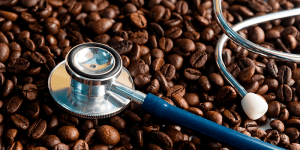Interacciones género y dósis dependientes entre el consumo de café y la actividad GGT en consumidores de alcohol
28-04-2017
Para explorar el papel del café como factor protector de la enfermedad hepática de origen alcohólico, los investigadores del estudio recolectaron información de cerca de 20.000 personas sobre su consumo de café, alcohol y sus niveles séricos de gamma glutamil transpeptidasa (GGT). De la población a estudio, el 89,8 % reportaron diferentes grados de consumo de café. En los hombres, la elevación de la GGT inducida por la ingesta pesada de alcohol (más de 280 gramos al día) se redujo significativamente por el consumo de más de cuatro tazas de café al día. Los resultados del estudio evidenciaron que el café modula el efecto del etanol sobre la GGT sérica, dependiendo de la dosis y del género del paciente.
Danielsson J, Kangastupa P, Laatikainen T, Aalto M, Niemelä O. Dose- and Gender-dependent Interactions between Coffee Consumption and Serum GGT Activity in Alcohol Consumers. Alcohol and Alcoholism Vol. 48, No. 3, pp. 303–307, 2013.
Agardh EE, Carlsson S, Ahlbom A et al. (2004) Coffee consumption,
type 2 diabetes and impaired glucose tolerance in Swedish
men and women. J Intern Med 255:645–52.
Alatalo PI, Koivisto HM, Hietala JP et al. (2008) Effect of moderate
alcohol consumption on liver enzymes increases with increasing
body mass index. Am J Clin Nutr 88:1097–103.
Alatalo PI, Koivisto HM, Hietala JP et al. (2009) Gender-dependent
impacts of body mass index and moderate alcohol consumption
on serum uric acid—an index of oxidant stress status? Free
Radic Biol Med 46:1233–8.
Arnesen E, Huseby NE, Brenn T et al. (1986) The Tromso Heart
Study: distribution of, and determinants for, gammaglutamyltransferase
in a free-living population. Scand J Clin Lab
Invest 46:63–70.
Bidel S, Hu G, Qiao Q et al. (2006) Coffee consumption and risk
of total and cardiovascular mortality among patients with type 2
diabetes. Diabetologia 49:2618–26.
Bidel S, Silventoinen K, Hu G et al. (2008) Coffee consumption,
serum gamma-glutamyltransferase and risk of type II diabetes.
Eur J Clin Nutr 62:178–85.
Breitling LP, Raum E, Müller H et al. (2009) Synergism between
smoking and alcohol consumption with respect to serum
gamma-glutamyltransferase. Hepatology 49:802–8.
306 Danielsson et al.
Downloaded from http://alcalc.oxfordjournals.org/ at Universidad de los Andes on September 4, 2013
Casiglia E, Spolaore P, Ginocchio G et al. (1993) Unexpected
effects of coffee consumption on liver enzymes. Eur J
Epidemiol 9:293–7.
Corrao G, Bagnardi V, Zambon A et al. (2004) A meta-analysis of
alcohol consumption and the risk of 15 diseases. Prev Med
38:613–9.
Costentin CE, Roudot-Thoraval F, Zafrani ES et al. (2011)
Association of caffeine intake and histological features of
chronic hepatitis C. J Hepatol 54:1123–9.
Dey A, Cederbaum AI. (2006) Alcohol and oxidative liver injury.
Hepatology 43:S63–S74.
Emdin M, Pompella A, Paolicchi A. (2005) Gammaglutamyltransferase,
atherosclerosis, and cardiovascular disease:
triggering oxidative stress within the plaque. Circulation
112:2078–80.
Floegel A, Pischon T, Bergmann MM et al. (2012) Coffee consumption
and risk of chronic disease in the European
Prospective Investigation into Cancer and Nutrition (EPIC)—
Germany study. Am J Clin Nutr 95:901–8.
Freedman ND, Everhart JE, Lindsay KL et al. (2009) Coffee intake
is associated with lower rates of liver disease progression in
chronic hepatitis C. Hepatology 50:1360–9.
Freedman ND, Park Y, Abnet CC et al. (2012) Association of
coffee drinking with total and cause-specific mortality. N Engl J
Med 366:1891–904.
Grassi F, Tell G, Robbie-Ryan M et al. (2007) Oxidative stress
causes bone loss in estrogen-deficient mice through enhanced
bone marrow dendritic cell activation. Proc Natl Acad Sci USA
104:15087–92.
Gressner OA (2009) Less Smad2 is good for you! A scientific
update on coffee’s liver benefits. Hepatology 50:970–8.
Gunzerath L, Faden V, Zakhari S et al. (2004) National Institute on
Alcohol Abuse and Alcoholism report on moderate drinking.
Alcohol Clin Exp Res 28:829–47.
Higdon JV, Frei B. (2006) Coffee and health: a review of recent
human research. Crit Rev Food Sci Nutr 46:101–23.
Hu G, Tuomilehto J, Pukkala E et al. (2008) Joint effects of coffee
consumption and serum gamma-glutamyltransferase on the risk
of liver cancer. Hepatology 48:129–36.
Huber WW, Scharf G, Rossmanith W et al. (2002) The coffee components
kahweol and cafestol induce gamma-glutamylcysteine
synthetase, the rate limiting enzyme of chemoprotective glutathione
synthesis, in several organs of the rat. Arch Toxicol
75:685–94.
Ikeda M, Maki T, Yin G et al. (2010) Relation of coffee consumption
and serum liver enzymes in Japanese men and women with
reference to effect modification of alcohol use and body mass
index. Scand J Clin Lab Invest 70:171–9.
Inoue M, Yoshimi I, Sobue T et al. (2005) Influence of
coffee drinking on subsequent risk of hepatocellular
carcinoma: a prospective study in Japan. J Natl Cancer Inst
97:293–300.
Kazemi-Shirazi L, Endler G, Winkler S et al. (2007) Gamma glutamyltransferase
and long-term survival: is it just the liver? Clin
Chem 53:940–6.
Kendrick SF, Day CP. (2007) A coffee with your brandy, sir?
J Hepatol 46:980–2.
Klatsky AL, Armstrong MA. (1992) Alcohol, smoking, coffee, and
cirrhosis. Am J Epidemiol 136:1248–57.
Klatsky AL, Morton C, Udaltsova N et al. (2006) Coffee, cirrhosis,
and transaminase enzymes. Arch Intern Med 166:1190–5.
Kozakova M, Palombo C, Eng MP et al. (2012) Fatty liver index,
gamma-glutamyltransferase, and early carotid plaques. Hepatology
55:1406–15.
Lança AJ, Israel Y. (1991) Histochemical demonstration of sinusoidal
gamma-glutamyltransferase activity by substrate protection
fixation: comparative studies in rat and guinea pig liver.
Hepatology 14:857–63.
Lee DH, Jacobs DR, Jr, Gross M et al. (2003) Gamma-glutamyltransferase
is a predictor of incident diabetes and hypertension:
the Coronary Artery Risk Development in Young Adults
(CARDIA) Study. Clin Chem 49:1358–66.
Lee DH, Blomhoff R, Jacobs DR, Jr. (2004) Is serum gamma glutamyltransferase
a marker of oxidative stress? Free Radic Res
38:535–9.
Lee DH, Ha MH, Kam S et al. (2006a) A strong secular trend in
serum gamma-glutamyltransferase from 1996 to 2003 among
South Korean men. Am J Epidemiol 163:57–65.
Lee DH, Silventoinen K, Hu G et al. (2006b) Serum gammaglutamyltransferase
predicts non-fatal myocardial infarction and
fatal coronary heart disease among 28,838 middle-aged men and
women. Eur Heart J 27:2170–6.
Leino A, Impivaara O, Irjala K et al. (1995) Health-based reference
intervals for ALAT, ASAT and GT in serum, measured according
to the recommendations of the European Committee for
Clinical Laboratory Standards (ECCLS). Scand J Clin Lab
Invest 55:243–50.
Mason JE, Starke RD, Van Kirk JE. (2010) Gamma-glutamyl transferase:
a novel cardiovascular risk biomarker. Prev Cardiol 13:36–41.
Mistry D, Stockley RA. (2010) Gamma-glutamyl transferase: the
silent partner? COPD 7:285–90.
Modi AA, Feld JJ, Park Y et al. (2010) Increased caffeine consumption
is associated with reduced hepatic fibrosis. Hepatology
51:201–9.
Nilssen O, Førde O, Brenn T. (1990) The Tromso Study.
Distribution and population determinants of gammaglutamyltransferase.
Am J Epidemiol 132:318–26.
Poikolainen K, Vartiainen E. (1997) Determinants of gammaglutamyltransferase:
positive interaction with alcohol and body
mass index, negative association with coffee. Am J Epidemiol
146:1019–24.
Ruhl CE, Everhart JE. (2005) Coffee and tea consumption are associated
with a lower incidence of chronic liver disease in the
United States. Gastroenterology 129:1928–36.
Ruttmann E, Brant LJ, Concin H et al. The Vorarlberg Health
Monitoring and Promotion Program Study Group. (2005)
Gamma-glutamyltransferase as a risk factor for cardiovascular
disease mortality: an epidemiological investigation in a cohort of
163,944 Austrian adults. Circulation 112:2130–7.
Ryu S, Chang Y, Woo HY et al. (2010) Longitudinal increase in
gamma-glutamyltransferase within the reference interval predicts
metabolic syndrome in middle-aged Korean men. Metabolism
59:683–9.
Shimazu T, Tsubono Y, Kuriyama S et al. (2005) Coffee consumption
and the risk of primary liver cancer: pooled analysis of two
prospective studies in Japan. Int J Cancer 116:150–4.
Speisky H, MacDonald A, Giles G et al. (1985) Increased loss and
decreased synthesis of hepatic glutathione after acute ethanol administration.
Turnover studies. Biochem J 225:565–72.
Tanaka K, Tokunaga S, Kono S et al. (1998) Coffee consumption
and decreased serum gamma-glutamyltransferase and aminotransferase
activities among male alcohol drinkers. Int J Epidemiol
27:438–43.
Targher G. (2010) Elevated serum gamma-glutamyltransferase activity
is associated with increased risk of mortality, incident type
2 diabetes, cardiovascular events, chronic kidney disease and
cancer—a narrative review. Clin Chem Lab Med 48:147–57.
Tverdal A, Skurtveit S. (2003) Coffee intake and mortality from
liver cirrhosis. Ann Epidemiol 13:419–23.
Tynjälä J, Kangastupa P, Laatikainen T et al. (2012) Effect of age
and gender on the relationship between alcohol consumption
and serum GGT: time to recalibrate goals for normal ranges.
Alcohol Alcohol 47:558–62.
Vitaglione P, Morisco F, Mazzone G et al. (2010) Coffee reduces
liver damage in a rat model of steatohepatitis: the underlying
mechanisms and the role of polyphenols and melanoidins.
Hepatology 52:1652–61.
The World Health Organization (1988) The World Health
Organization MONICA Project (Monitoring trends and determinants
in cardiovascular disease): a major international collaboration.
WHO MONICA Project Principal Investigators. J Clin
Epidemiol 41:105–14.
Zhang H, Forman HJ. (2009) Redox regulation of gamma-glutamyl
transpeptidase. Am J Respir Cell Mol Biol 41:509–15.















